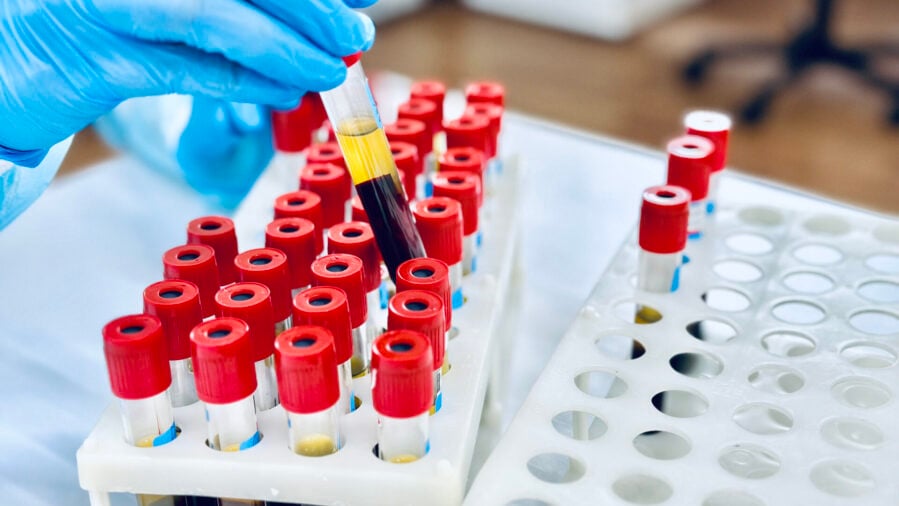Keck School of Medicine of USC researchers have developed a blood test that could change how we screen for Alzheimer’s disease years before symptoms appear.
The new test, called 5ADCSI (Penta-Plex Alzheimer’s Disease Capture Sandwich Immunoassay), detects five key biomarkers simultaneously—more than any commercially available blood test—while running on equipment already common in many laboratories. This approach significantly reduces costs, potentially making widespread early screening for Alzheimer’s as routine as cholesterol tests, opening new possibilities for early intervention when treatments might be most effective.
The proof-of-concept study, recently published in the Journal of Alzheimer’s Disease and funded by the National Institutes of Health, demonstrates how this affordable testing method could transform our approach to a disease that typically develops silently over decades.
How the Test Works: Detecting Multiple Biomarkers at Once
“The biggest advantage is that our test is very cost-effective compared to other existing technologies, and it’s relatively easy to implement because many laboratories in universities, hospitals, and clinics are already using this technology,” said Ebrahim Zandi, PhD, associate professor of molecular microbiology and immunology at the Keck School of Medicine, who led the research.
Unlike existing tests that are expensive and limited in scope, 5ADCSI leverages widely available xMAP® technology from Luminex. The system uses tiny color-coded beads coated with antibodies that bind to specific Alzheimer’s biomarkers in blood samples:
- Two types of amyloid proteins (Aβ40 and Aβ42)
- Phosphorylated tau
- Neurofilament light chain (NfL)
- Glial fibrillary acidic protein (GFAP)
When these proteins are present in a blood sample, they bind to the beads. Powerful imaging sensors then detect the colors emitted, allowing researchers to measure biomarker levels with remarkable precision.
Early Detection: The Key to Intervention
What makes this test particularly promising is its potential to detect Alzheimer’s in its earliest stages, long before cognitive symptoms appear. But why does early detection matter so much?
“In the 10 to 20 years Alzheimer’s takes to develop, proteins such as amyloid and tau are slowly building up,” Zandi explained. “If we have an affordable blood test that detects those proteins early on, we can start interventions long before symptoms begin.”
In their study, researchers tested blood samples from 63 participants across three groups: 11 patients with Alzheimer’s disease, 17 with mild cognitive impairment (a potential precursor to Alzheimer’s), and 35 healthy individuals. As expected, the test detected the highest biomarker levels in Alzheimer’s patients, followed by those with mild cognitive impairment.
From Lab to Clinical Practice
The journey of 5ADCSI began as a practical solution. Christopher Beam, PhD, associate professor of psychology at USC Dornsife College of Letters, Arts and Sciences, needed a more affordable way to measure Alzheimer’s biomarkers for his studies on cognitive aging. Zandi’s team provided the solution with 5ADCSI.
To validate their findings, researchers also tested cerebrospinal fluid samples, which typically contain higher concentrations of Alzheimer’s-associated proteins but are much more difficult and expensive to collect. They found moderate to strong correlations between blood and cerebrospinal fluid results, suggesting the blood test is sensitive enough for early detection.
The researchers are now working to test 5ADCSI’s accuracy with several hundred patients across different stages of Alzheimer’s disease, moving it closer to clinical application.
Toward Routine Brain Health Screening
Zandi envisions a future where this technology becomes part of routine health screenings worldwide. His team’s long-term goal is to create a comprehensive brain health risk assessment that combines 5ADCSI with genetic testing for APOE4, the gene variant linked to increased Alzheimer’s risk.
Such an approach could transform Alzheimer’s from a devastating diagnosis into a manageable condition through early intervention with medications and lifestyle modifications, such as increased exercise, that might slow or prevent cognitive decline.
The affordable nature of the test is particularly significant given the growing global burden of dementia. By relying on technology that’s already widely available, even outside the U.S., this testing approach could democratize access to early Alzheimer’s detection in regions where advanced healthcare resources are limited.
As researchers continue to refine this technology, it raises an intriguing possibility: Could regular brain health assessments eventually become as routine as annual physicals? With tools like 5ADCSI, we might be moving closer to a future where Alzheimer’s can be identified and addressed before it takes its toll.
If our reporting has informed or inspired you, please consider making a donation. Every contribution, no matter the size, empowers us to continue delivering accurate, engaging, and trustworthy science and medical news. Independent journalism requires time, effort, and resources—your support ensures we can keep uncovering the stories that matter most to you.
Join us in making knowledge accessible and impactful. Thank you for standing with us!

